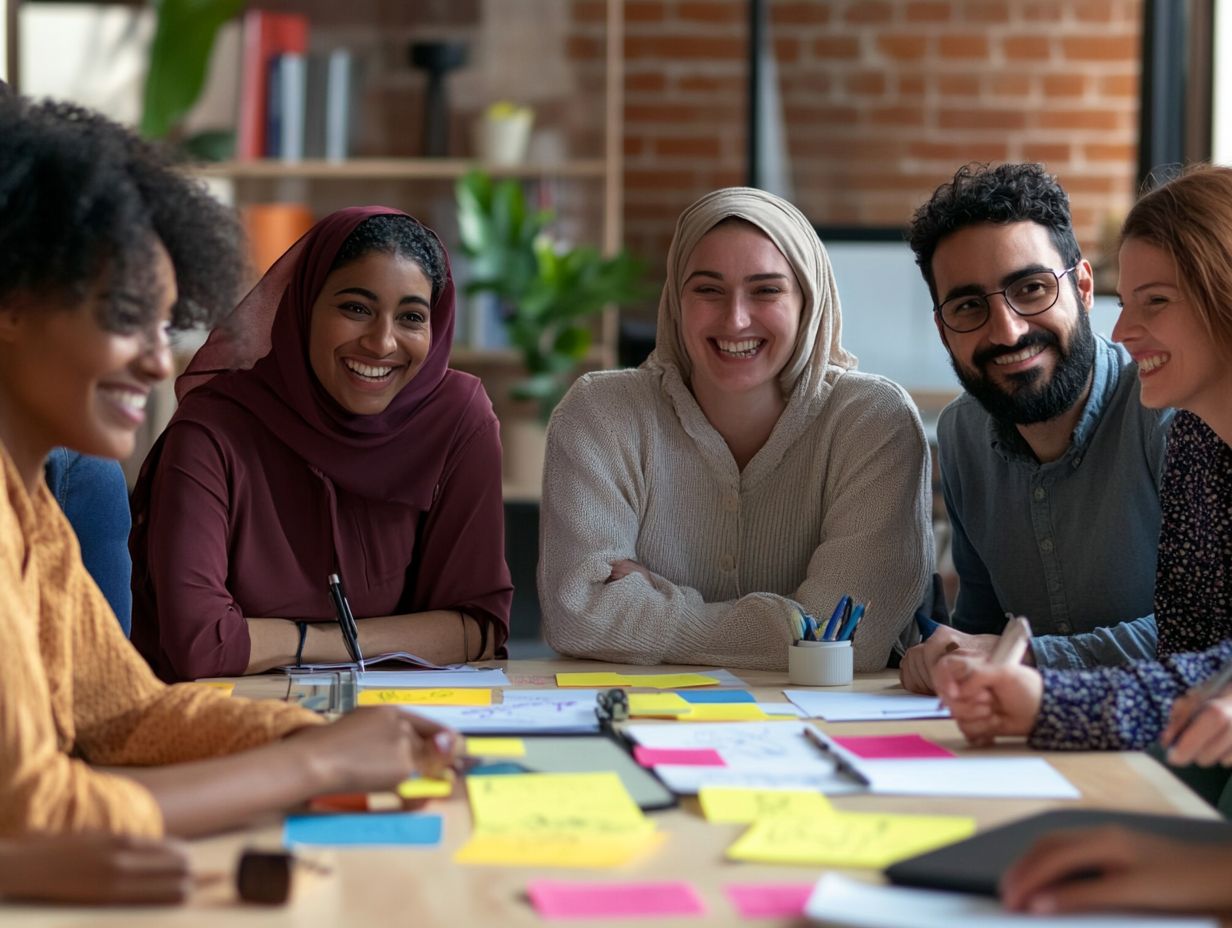The Role of Creativity in Problem Solving
In today s fast-paced world, your capacity to think creatively is more essential than ever for effective problem solving. Creativity not only offers fresh perspectives but also cultivates innovative solutions that can lead to significant breakthroughs.
This article delves into the creative process, emphasizing practical steps to nurture your creativity, identify barriers, and harness divergent thinking. Through real-life case studies, discover how creativity can change the game for you.
Explore with us as we unveil the vital role creativity plays in overcoming obstacles and enhancing your problem-solving skills.
Contents
Key Takeaways:

Creativity helps us solve problems effectively as it allows us to think outside the box and develop innovative solutions. The creative process involves steps like brainstorming, ideation, and experimentation, which can be enhanced through techniques like mind mapping and role-playing. Identifying and overcoming barriers to creativity, such as fear of failure and lack of diverse perspectives, can significantly improve problem-solving abilities.
The Importance of Creativity in Problem Solving
Creativity is crucial in navigating problem-solving, especially in today s dynamic business landscape, where complex challenges require innovative solutions.
Leaders must encourage creativity by empowering team members and creating an environment of psychological safety where diverse perspectives can flourish.
By embracing critical thinking and creative processes, organizations can tap into their workforce’s creative potential, driving growth and addressing unresolved challenges.
This requires a growth mindset among team members, encouraging them to seek hands-on opportunities and engage in collaborative projects that lead to effective problem-solving.
Why Creativity is Essential for Effective Problem Solving
Creativity plays a pivotal role in effective problem-solving, empowering you to craft innovative solutions for complex challenges.
This imaginative capacity sharpens your critical thinking and encourages exploring multiple pathways toward solutions.
For instance, a team brainstorming session can spark a variety of marketing strategies tailored to different demographics, significantly enhancing your chances of reaching a broader audience.
In educational environments, when students engage in creative activities like group projects or artistic endeavors they bolster their analytical skills, making them more adept at tackling diverse problems.
Ultimately, nurturing creativity cultivates a more flexible mindset, enabling you to navigate obstacles with confidence and adapt seamlessly to new situations.
The Creative Process
The creative process unfolds as an intricate journey, guiding you through stages from the initial spark of ideation to the exciting world of experimentation.
Each phase tackles problem statements while encouraging the exploration of new and innovative ideas.
Steps to Foster Creativity
Fostering creativity requires deliberate steps, such as engaging in brainstorming sessions and providing hands-on opportunities through workshops and collaborative projects.
These activities can significantly enhance your innovative thinking, especially in a culture that encourages risk-taking and open dialogue.
By implementing regular brainstorming sessions, you tap into a wealth of ideas, ensuring that every voice is heard.
Workshops tailored for skill enhancement and concept exploration create a productive environment where you feel empowered to contribute freely.
Collaborative projects create synergy among diverse talents, showcasing the remarkable power of teamwork in generating unique solutions.
Establishing a supportive environment is essential one that embraces creativity as a journey rather than a mere destination.
Barriers to Creativity in Problem Solving

Barriers to creativity in problem-solving can profoundly impede organizational growth, often arising from a lack of psychological safety and insufficient critical analysis of the surrounding environment.
Start nurturing your creativity today to unlock your problem-solving potential!
Identifying and Overcoming Obstacles
Identifying and overcoming obstacles to creativity is vital for promoting effective problem-solving.
Nurturing a culture of innovation within your organization requires recognizing various barriers that can stifle creativity, like fear of failure or strict company structures.
To address these challenges, actively encourage open dialogue and feedback, allowing individuals to express their ideas without fear of judgment. Consider introducing regular brainstorming sessions and workshops to promote collaborative thinking.
This approach enables team members to explore diverse perspectives and enriches the creative process. Cultivating a safe space for sharing ideas gives your team the power to take calculated risks and engage in creative exploration, ultimately leading to groundbreaking solutions that can significantly benefit your organization.
The Role of Divergent Thinking
Divergent thinking is essential for cultivating innovative solutions, inviting you to explore a vast array of possibilities in a creative environment.
By engaging in brainstorming and idea generation, you can unlock new perspectives and unleash your full creative potential.
Using Divergent Thinking to Generate Solutions
Using divergent thinking to generate solutions means embracing exploratory brainstorming sessions where every idea is welcome, no matter how unconventional it may seem. This approach invites you to step beyond traditional boundaries and explore a vast spectrum of possibilities.
Consider a team assigned to redesign a product. They might kick things off by listing features that don t currently exist, which opens the door to discussions about innovative materials and new functionalities.
To enhance the brainstorming experience, techniques like mind mapping can help you visualize connections between ideas. Setting a timer for short, focused bursts of ideation can inject energy and urgency into the process.
Incorporating role-playing also offers fresh perspectives, broadening the pool of creative solutions even further.
Examples of Creativity in Problem Solving
Explore remarkable examples of creativity in problem-solving through a range of real-life case studies that showcase innovative solutions and the power of interdisciplinary collaboration.
Real-life Case Studies

Real-life case studies demonstrate how your creativity can drive innovative solutions to complex problems across various sectors, including business and education. These examples underscore the power of collaborative efforts, where diverse teams unite to brainstorm and implement inventive strategies.
Take, for instance, a notable case in the tech industry: a software company grappling with declining user engagement. By assembling a cross-functional team of designers, engineers, and data analysts, they adopted a user-centric approach. They held workshops to gather insights directly from users, ultimately leading to the development of features that significantly enhanced the user experience.
In a similar vein, a school district addressed student drop-out rates by creating mentorship programs and leveraging community resources, resulting in a remarkable surge in graduation rates. Through these instances, it becomes clear how applying creative problem-solving can yield transformative outcomes.
Nurturing Creativity in Problem Solving
Nurturing creativity in problem-solving demands a strategic approach filled with practical tips and techniques that foster teamwork and enhance social awareness among team members.
By cultivating an environment where collaboration flourishes and diverse perspectives are valued, you give your team the power to tackle challenges with innovative solutions.
Start fostering an environment of creativity today and watch your team’s innovative potential soar!
Practical Tips and Techniques
Practical tips for enhancing creativity in problem-solving include fostering a supportive atmosphere and encouraging open dialogue. Use team workshops to stimulate innovative thinking.
These strategies are essential for creating an environment where you feel secure enough to express your ideas without fear of judgment. A supportive atmosphere helps you and your team members take risks and think outside the box.
This openness paves the way for discovery and innovation, allowing diverse perspectives to unite, which can spark exciting and unique solutions.
Structured team workshops can also be a game-changer, guiding discussions and brainstorming sessions while providing a collaborative platform. By employing techniques like mind mapping, which visually organizes ideas, or design thinking, which focuses on understanding users to solve problems creatively, your team can explore various avenues. This approach makes the creative process not only more dynamic but also significantly more effective.
Frequently Asked Questions
What is the role of creativity in problem solving?
Creativity plays a crucial role in problem-solving as it allows individuals to think outside the box and come up with innovative solutions. Understanding the role of imagination in creative processes can help approach problems from different angles.
How does creativity help in problem solving?

Creativity helps in problem-solving by encouraging individuals to use their imagination and tap into their creative thinking skills. This results in the generation of unique and original ideas that can lead to effective solutions.
Can everyone be creative in problem solving?
Yes, everyone has the potential to be creative in problem-solving. While some individuals may have a natural inclination towards creativity, it is also a skill that can be developed and improved through practice and experimentation.
Why is creativity important in problem solving?
Creativity is important in problem-solving because it allows for the exploration of unconventional and novel solutions that may not have been considered before. It also helps individuals break out of traditional thought patterns and come up with unique ways to approach a problem.
How can one improve their creativity in problem solving?
There are several ways to improve creativity in problem-solving, including practicing brainstorming techniques, exposing oneself to new and diverse experiences, and taking breaks to allow for subconscious thinking. Keeping an open mind and being willing to take risks can also enhance creativity in problem-solving.
Can creativity be taught or learned?
While some individuals may have a natural inclination towards creativity, it is a skill that can also be taught and learned. By practicing different techniques and approaches, individuals can improve their creative thinking abilities and apply them to problem-solving.






